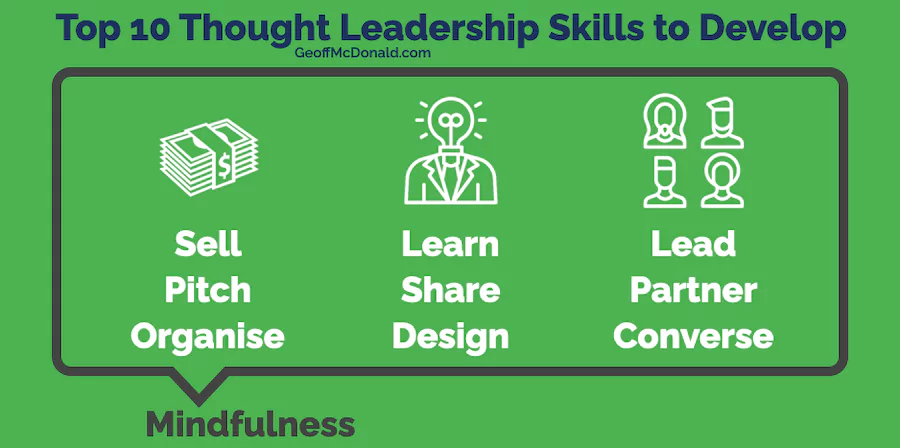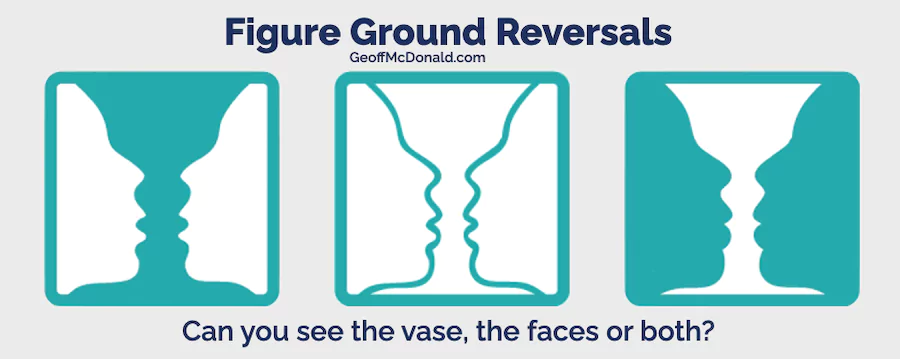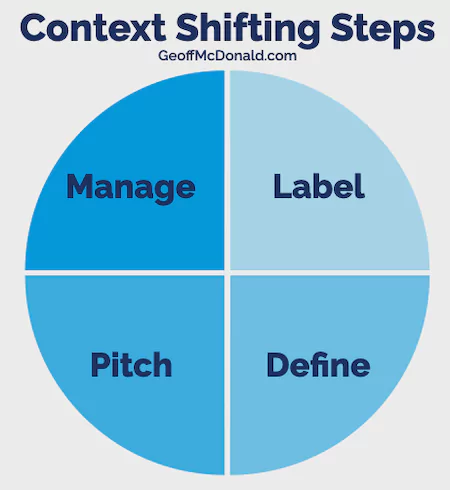Which thought leadership skills are the best to grow and develop?
You want to earn money from what you know so you can be rewarded for your experience and expertise. But what’s stopping you or slowing you down is that you’re missing some of the essential skills to share your ideas in ways that people will pay you.
The big question is: Which skills do you need to develop?
You don’t want to waste your time working on the wrong things.
In this post, I’ll share ten skills every thought leader needs to develop. Most importantly, I’ll focus on the one essential skill you must develop to lead with your ideas.
Steve Martin’s Advice for a Successful Career
Steve Martin is telling you to get good. Great. But at what?
To be an influential, impactful thought leader who earns good dollars, what do you have to be good at?
Top Ten Thought Leadership Skills to Develop
Over many years, I’ve given this a lot of thought because this is something that I want to achieve for myself. Here’s my top ten list of thought leadership skills you need to develop.
In the post, Thought Leader Strategy, I shared the three things every thought leader needs to build.
Thought leaders need to build capital in three areas:
- Business = money or financial capital
- Thoughts = ideas or intellectual capital
- Leadership = people or social capita
It follows that you need to develop skills across each of these three areas.
- Money skills
- Idea skills
- People skills
Based on this, I’ve picked three skills in each of these areas for you to focus on.
Money Skills to Develop
In the area of money skills, you need to be able to:
- Sell – it’s essential that you can sell yourself, your ideas and your services. For some people in becoming a thought leader, standing up and selling your ideas will be the toughest test – it will require confidence, courage and conviction.
- Pitch – you need to skills in persuasion and influence to successfully pitch your ideas and communicate your message
- Organized – to be effective in business you need to be organised to make things happen. This includes managing your money when you do earn it.
Idea Skills to Develop
In the area of idea skills, you need to be able to:
- Learn – if you’re not learning you’re not staying ahead of your clients
- Share – the better you can share your ideas the more easily you can attract clients
- Design – you need to be able to design and package and frame your ideas so others can engage with them
People Skills to Develop
In the area of people skills, you need to be able to:
- Lead – you need to be able to lead yourself and other people using your ideas. This can be tricky for many people, leading with your own ideas takes confidence, courage and conviction.
- Partner – you need to work with, partner and collaborate with clients and colleagues
- Converse – you need to be able to manage and lead conversations
That’s nine essential skills. I said I’d offer ten essential skills.
This next one is the one essential skill I’d say that everyone needs to develop. It’s the all-purpose, swiss army knife ultimate skill that is powerful in any situation. The answer is: mindfulness – being able to pay attention to the things that are important in life and work. It’s the key to being happy, healthy and building loving relationships.
What do you think, which items on my top ten list do you agree with? What would you add or change to this list?
The Missing Thought Leadership Skill
While I think these ten skills are all important, they don’t define you as a thought leader.
They could be applied as essential skills for almost all knowledge-based careers.
There’s one crucial thing that is missing.
I believe it is the one skill that makes you a thought leader or not. If you can’t do this, it’s unlikely that you’ll become a true thought leader.
And I hinted at it in my previous post – The best types of Thought Leadership Content to create.
The Purpose of Ideas
Thought leaders earn money by leading with their ideas.
The purpose of ideas is to point the way to better action and therefore better results. And there are two levels at which this occurs.
- This one is obvious – it’s the practical steps, the processes and the moves we make.
- The second is less obvious but perhaps more important – it’s the ideas that tell us what actions to take. It’s the context we operate from.
Most leaders and managers lead because they define the actions to take. But what separates a thought leader from the usual leader is that they define the context for taking that action.
The Essential Skill
The number one skill – the essential skill – of a thought leader is Context Shifting. A thought leader is a master of context shifting – the ability to read the background context people are operating from. And if needed, shift this context to create new possibilities, new opportunities and new action.
You might like to think of this as identifying the frame of reference that you are operating from.
Gary Vaynerchuk said it beautifully – If content is king, context is god.
Context Shifting Examples
Now, let’s look at some familiar examples of context and context shifting.
1 Football or Church
If you are at a football match, there is a social convention that says you can make a lot of noise cheering for your team. But in church or in school, we don’t do that. This is the role of context telling us how to act.
2 Jokes
Humour and jokes work because they change our context so that we see things from a different perspective. For example: Why did the taxi driver get fired? Passengers didn’t like it when she went the extra mile. (Source: Best Life Online)
3 Identity
Our most important personal context is our sense of identity. The way we see ourselves shapes whether we apply for that job or we ask that girl out on a date. Currently, there are big shifts in gender identity that is changing how we see ourselves and others.
4 Purpose and Values
An important context that shapes what action we take is our purpose and values.
- Are you on purpose?
- Are you living true to your values?
5 Past, Present and Future
One of the most powerful contexts we all operate from is the past, present and future.
- Are you living in the past?
- Present to now?
- Or dreaming about the future?
How to Shift the Context
Now for the crucial question, how do you shift the context? There are four stages here.
1 Label
First, you need to label the current situation. Most of the time we are not aware of the context we are operating in or from. It sits in the background. When you label it, the background becomes the foreground.
It’s an example of a Figure-Ground Reversal. You might be familiar with visual examples of this: Can you see the vase or the head or both?
Choose your labels carefully because every new label is a new context.
2 Define
Next, we want to define an alternative – a context that we might shift to. This might be the opposite – from dark to light or it might be a brand-new context.
You might recall this is central to the Content Pillar model I have shared previously, which has a number of context shifts built into its design:
- You have a shift from Now to the Future.
- A Shift from having a Problem and having the Problem Resolved.
- Plus you have the Usual Solution and then Your Solution
 3 Pitch
3 Pitch
Now that you have what you consider to be a better way forward, you need to pitch and present this to your audience. This is crucial if you want your shift to be adopted. This is all about managing a change and this might mean having a conversation about what’s not working and then creating a new way forward.
4 Manage
Finally, we want to manage the adoption of the new alternative. If a CEO walks into the room and says ‘We’re going to be Carbon Neutral by 2030’ and then leaves, then there is a good chance nothing will change.
How to Learn the Context Shifting Skill
To practice the art of the context shifting skill the easiest thing to do is watch or read the news. This will be particularly obvious in discussions around politics. There will be one side of politics speaking about one context and the other side speaking about the same issue from an entirely different context. For bonus points, see if you can spot what context the journalist or media outlet is portraying. Are they secretly and in a subtle way supporting one view or the other?
Tools for Thought Leaders
While this discussion might sound new, different or a bit conceptual, it’s more than likely that there are oodles of examples of context shifting happening around you and in front of your eyes. But you may not notice them because you’re not sure what to look for. To assist you with this, here are three familiar and quick ways you can use to lead conversations. You can spot them when others use them and use them yourself to grow your thought leadership skills.
1 Statistics
The right stat at the right time can make an instant shift for people.
Previously, I’ve shared a statistic from Harvard Business Review that says it’s 5-25 times more expensive to find a new client than retain an existing one. That completely changed my view of Content Marketing. Instead, of trying to compete on social media, I was better off creating content for my current clients.
2 Visual Models
Another tool you can use is a visual model. This is an easy way to show an alternative and contrast two ideas. There are a number of examples on this page.
Also, in talking about Capital Content I show these two slides. The Usual Way (a classic and simple label for the current context) and Capital Content (a new context).
3 Diagnosis
Coaches know that great questions can also shift a context very quickly. And you can easily turn this into a diagnostic tool.
For example, if I simply ask if you are working or not working right now, how would you respond? This question prompts you to consider what activity you’re doing right now and whether you consider it to be work. In other words, it prompts you to label your current context.
Summary of the most important Thought Leadership Skills to develop
Let’s wrap up what we’ve covered here…
- The key to being influential, impactful and earning good money as a thought leader is to build your skills.
- You will need to develop skills across the three domains of:
-
- Business – building financial capital
- Ideas – building intellectual capital
- People – building social capital
- The number one essential skill that every thought leader needs to build is context shifting.
- The key to context shifting is to look for the background conversation – bring it to the foreground for discussion.
More on Thought Leadership Skills
Here are some links to related content on Thought Leadership and Context Shifting:
- 1 Thought Leadership Content Marketing – Publishing your content is the perfect way to establish a new context and a new way of thinking
- 2 Thought Leadership Content – What is a Manifesto? – A manifesto is a declaration of your intent and it’s specifically intended to create a new context to operate from.
- 3 Thought Leadership Meaning and Definition – Changing a definition or a meaning is a great way to shift a context






 3 Pitch
3 Pitch



